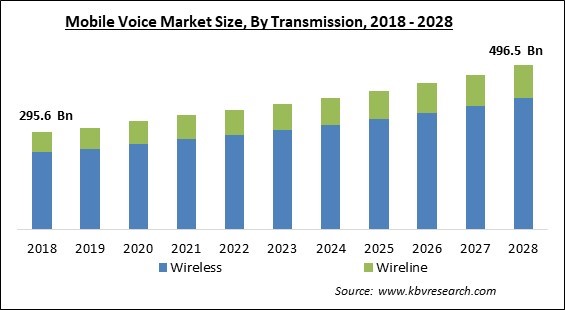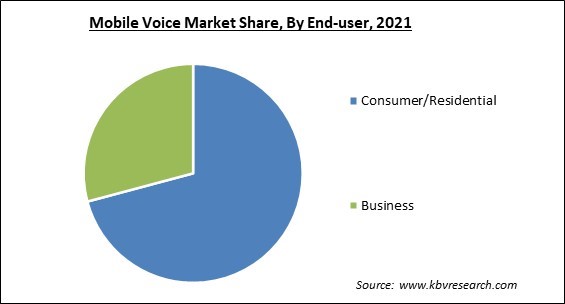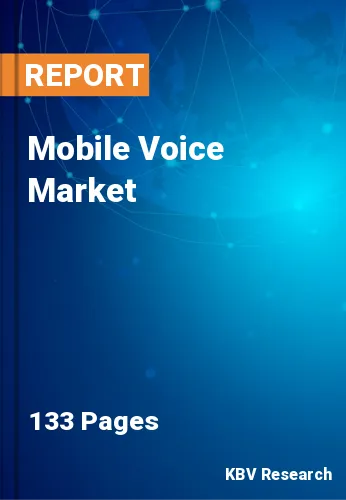The Global Mobile Voice Market size is expected to reach $496.5 billion by 2028, rising at a market growth of 5.4% CAGR during the forecast period.
Voice firewalls are used by MNOs to identify possible fraudulent voice traffic. A flash calling service provider provides these services. In contrast to SMS traffic, however, voice traffic adds a degree of complication owing to the emergence of technologies such as VoLTE and Vo5G. This is because these technologies require several network planes to transport IP-based traffic. Therefore, operators' networks will require a bigger presence of these voice firewalls to identify the volume of unmonetized traffic.

Due to the proliferation of next-generation technologies such as VoLTE and 5G, voice traffic is now transmitted via a data plane as opposed to a specialized voice aircraft. To guarantee that all of these locations are protected by a voice firewall, predict that the implementation of voice firewalls will be more expensive than an SMS firewall. Moreover, as the initial cost of a speech firewall rises, so do the costs associated with implementing a voice firewall on 5G and 5G networks, given their high levels of transparency.
Programmable voice is the capacity to initiate, manage, receive, and monitor calls using voice API software. Voice APIs not only enable an application to connect to a carrier network but also permit the application to manage the carrier service to execute a variety of voice activities, such as call recording and audio conferencing. As the demand for voice APIs grows, operators will be able to monetize these APIs by taking a cut of the income earned by each API request. In today's technological industry, the ability to utilize programmable speech is crucial, since the usage of multi-channel programmable communications is expanding due to the desire of brands and businesses to create a more engaging consumer experience.
Voice-programmable communications will be crucial to the future of the working world. This is a result of the adaptability of these voice APIs, which enables multinational organizations in any market vertical to utilize next-generation technologies without investing in considerable telecom infrastructure and knowledge. Through the integration of apps and workflows, these APIs also support better collaboration, customer engagement, and customer service, allowing brands and organizations to enhance internal efficiency, which will increase profitability.
Logistical issues prompted industrial businesses to investigate new automation technologies that compensate for increased wages and boost productivity. During a lockdown situation, a large number of individuals utilized do-it-yourself (DIY) goods to remain engaged and enhance their comfort at home. The market for voice assistants expanded significantly due to the steady increase in automation investments. The increasing use of voice assistants for automotive driver assistance systems and in-vehicle entertainment in the automobile industry. In addition, the growing understanding of the benefits of cloud-based solutions and their incorporation into voice assistant apps is anticipated to create attractive development potential for the voice application industry.
Large enterprises viewed VPNs as an efficient solution for the rising WAN costs, connecting remote users and integrating partners, suppliers, and customers into their networks. Small enterprises utilized VPNs because they were the first affordable WAN or remote-access solution. VPNs are anticipated to save businesses between 30% and 70% in comparison to alternative remote-access methods. The encrypted connection ensures that critical information is sent securely.
There is an increase in the number of individuals adopting artificial intelligence and robots in every part of their lives due to the development of technology. Voice user interfaces boost productivity by allowing the user to simultaneously do numerous activities. For instance, using the Voice user interface, the user may simultaneously cook and compose an email. In addition, a sizable portion of the older population prefers the Voice user interface since it facilitates typing, as their visual and motor abilities make reading and typing on smart devices difficult.
Although the Voice user interface facilitates the day-to-day lives of its users by enabling contact with machines and gadgets, the technology does not process voice inputs with absolute precision. The user interface for Voice is built on artificial intelligence that utilizes a designated lexicon. This dictionary contains several terms with similar pronunciations. In rare instances, the computer conflates words, resulting in an incorrect answer to the user's input. Inaccuracy in the Voice user interface results in grammatical and spelling faults in the output.
Based on the Transmission, the Mobile Voice Market is segmented into Wireline and Wireless. The wireless segment acquired the highest revenue share in the mobile voice market in 2021. Increasing consumer and business usage of wireless communication solutions to manage enterprise communication infrastructure is the primary driver of the segment's growth.

On the basis of End-User, the Mobile Voice Market is divided into Consumer/Residential and Business. The business segment recorded a substantial revenue share in the mobile voice market in 2021. It is due to the increased company operations, as well as an increase in cross-functional teams and remote workers, that have compelled businesses to integrate communication solutions at the organizational level to ensure efficient communication practices.
| Report Attribute | Details |
|---|---|
| Market size value in 2021 | USD 345.9 Billion |
| Market size forecast in 2028 | USD 496.5 Billion |
| Base Year | 2021 |
| Historical Period | 2018 to 2020 |
| Forecast Period | 2022 to 2028 |
| Revenue Growth Rate | CAGR of 5.4% from 2022 to 2028 |
| Number of Pages | 133 |
| Number of Tables | 239 |
| Report coverage | Market Trends, Revenue Estimation and Forecast, Segmentation Analysis, Regional and Country Breakdown, Companies Strategic Developments, Company Profiling |
| Segments covered | Transmission, End User, Region |
| Country scope | US, Canada, Mexico, Germany, UK, France, Russia, Spain, Italy, China, Japan, India, South Korea, Singapore, Malaysia, Brazil, Argentina, UAE, Saudi Arabia, South Africa, Nigeria |
| Growth Drivers |
|
| Restraints |
|
Region-wise, the Mobile Voice Market is analyzed across North America, Europe, Asia Pacific, and LAMEA. The Asia Pacific segment garnered the highest revenue share in the mobile voice market in 2021. The market is primarily driven by an emphasis on wireless network infrastructure, business use of cloud-based communication services, and a big consumer base. According to the poll, the region will likely acquire more than half of the mobile subscribers shortly, due to the region's high consumer demand and regional technological viability.
Free Valuable Insights: Global Mobile Voice Market size to reach USD 496.5 Billion by 2028
The market research report covers the analysis of key stake holders of the market. Key companies profiled in the report include AT&T, Inc., Verizon Communications, Inc., SoftBank Group Corporation, Deutsche Telekom AG, Telefonica S.A., Vodafone Group Plc, Nippon Telegraph and Telephone Corporation, China Mobile Limited, and KT Corporation.
By Transmission
By End User
By Geography
The global Mobile Voice Market size is expected to reach $496.5 billion by 2028.
Increased Usage Of VPN Networks And Investment In Networking Solutions By Businesses are driving the market in coming years, however, Lack Of Precision In Speech Output Processing restraints the growth of the market.
AT&T, Inc., Verizon Communications, Inc., SoftBank Group Corporation, Deutsche Telekom AG, Telefonica S.A., Vodafone Group Plc, Nippon Telegraph and Telephone Corporation, China Mobile Limited, and KT Corporation.
The expected CAGR of the Mobile Voice Market is 5.4% from 2022 to 2028.
The Consumer/Residential segment acquired maximum revenue share in the Global Mobile Voice Market by End-user in 2021 thereby, achieving a market value of $345.6 Billion by 2028.
The Asia Pacific market dominated the Global Mobile Voice Market by Region in 2021, and would continue to be a dominant market till 2028; thereby, achieving a market value of $182.7 Billion by 2028.
Our team of dedicated experts can provide you with attractive expansion opportunities for your business.

